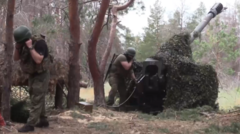
Mapping the Shifting Frontlines: Russia's Advances in Northern and Eastern Ukraine
The conflict in Ukraine remains a dynamic and fluid situation, with significant changes occurring along the northern and eastern frontlines. This article provides a detailed analysis, leveraging mapping data, of the Russian advances and the evolving territorial control. We will examine key strategic areas, the tactics employed, and the implications of these shifts in the ongoing conflict.
Northern Front: Focus on Kharkiv and the Surrounding Region
Initially, the northern front saw rapid advances by Russian forces aiming to encircle Kyiv. However, after encountering fierce resistance and logistical challenges, Russia refocused its efforts on consolidating control in the Kharkiv region and securing a land bridge to the Donbas.
Kharkiv: A City Under Siege and Persistent Assault
Kharkiv, Ukraine's second-largest city, has been a primary target for Russian forces since the beginning of the invasion. The city has endured relentless shelling and missile strikes, resulting in significant civilian casualties and infrastructure damage. While Russian troops haven't fully captured Kharkiv, they have made incremental gains in the surrounding areas, threatening to encircle the city.
- Key Strategic Importance: Kharkiv's location near the Russian border makes it a crucial logistical hub and a potential staging ground for further advances into Ukraine.
- Current Situation: Ukrainian forces continue to defend Kharkiv fiercely, preventing a complete Russian takeover. However, the city remains under constant threat.
- Russian Tactics: Primarily relying on artillery and air strikes to degrade Ukrainian defenses before attempting ground offensives.
Advances Towards Izyum and the Southern Approaches to Kharkiv
To the south of Kharkiv, Russian forces have been pushing towards Izyum, a strategically important town that controls a key highway leading to the Donbas region. Capturing Izyum would allow Russia to reinforce its troops in the east and potentially encircle Ukrainian forces in the Donbas.
- Izyum's Strategic Value: Controls a vital transportation route and provides access to the Donbas region.
- Russian Objectives: To secure Izyum and establish a strong foothold for further advances into the Donbas.
- Ukrainian Resistance: Fierce fighting continues in the Izyum area, with Ukrainian forces attempting to hold the line against the Russian onslaught.
Eastern Front: The Battle for the Donbas
The Donbas region, comprised of the self-proclaimed Donetsk and Luhansk People's Republics, has been the epicenter of the conflict since 2014. Russia's primary objective in the east is to fully capture the Donbas and secure its territorial claims.
Luhansk: Gradual Russian Gains and Encirclement Efforts
In the Luhansk region, Russian forces have been making steady progress, capturing several key towns and villages. The focus is on encircling Ukrainian forces in the cities of Severodonetsk and Lysychansk, the last major Ukrainian strongholds in the Luhansk region.
- Severodonetsk and Lysychansk: The last major Ukrainian strongholds in the Luhansk region.
- Russian Strategy: To encircle these cities and force a Ukrainian withdrawal or surrender.
- Impact on Ukrainian Forces: Losing Severodonetsk and Lysychansk would significantly weaken Ukraine's control over the Luhansk region.
Donetsk: Intense Fighting and Incremental Advances
In the Donetsk region, the fighting has been particularly intense, with both sides suffering heavy casualties. Russian forces have been focusing on capturing the strategic city of Avdiivka, which lies near the city of Donetsk and has been a key Ukrainian defensive position since 2014.
- Avdiivka's Importance: A heavily fortified city that has been a key Ukrainian defensive position for years.
- Russian Assault: Russian forces have been launching relentless attacks on Avdiivka, attempting to break through Ukrainian defenses.
- Consequences of Capture: Capturing Avdiivka would allow Russia to consolidate its control over the Donetsk region and potentially launch further offensives towards other key cities.
Tactics and Challenges for Both Sides
The conflict in Ukraine has highlighted the evolving nature of modern warfare, with both sides adapting their tactics and strategies in response to the changing battlefield dynamics.
Russian Tactics: Firepower and Attrition
Russian forces have primarily relied on overwhelming firepower, using artillery, air strikes, and missile attacks to degrade Ukrainian defenses before attempting ground offensives. Their strategy focuses on attrition, slowly grinding down Ukrainian forces and infrastructure.
Ukrainian Tactics: Asymmetric Warfare and Mobile Defense
Ukrainian forces have employed a combination of asymmetric warfare tactics, including the use of anti-tank weapons, drones, and partisan activity, to inflict heavy losses on Russian forces. They have also adopted a mobile defense strategy, using maneuverability and deception to disrupt Russian advances.
Logistical Challenges and Supply Lines
Both sides face significant logistical challenges in maintaining supply lines and providing essential resources to their troops. Russian forces have struggled with logistical bottlenecks and equipment failures, while Ukrainian forces rely heavily on Western military aid to sustain their defense efforts.
Implications and Future Outlook
The Russian advances in northern and eastern Ukraine have significant implications for the future of the conflict. The capture of key cities and regions would allow Russia to consolidate its control over the Donbas and potentially establish a land bridge to Crimea.
However, the conflict is far from over. Ukrainian forces continue to resist fiercely, and the country's Western allies are providing substantial military and economic aid. The outcome of the war will depend on the ability of both sides to sustain their efforts and adapt to the changing battlefield dynamics.
The situation remains highly volatile, and further analysis will be required to fully understand the long-term consequences of the ongoing conflict. This article will be updated as new information becomes available.
```